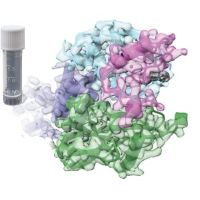Specification
| Description | Recombinant protein from the full-length sequence of Homo sapiens C-C motif chemokine ligand 20 (CCL20), transcript variant 1 (NM_004591). |
| Organism | Homo sapiens (Human) |
| Expression Host | Human Cells |
| Tag Info | His or DYKDDDDK. Please contact us if you need further information or require specific designed tag. |
| Purity | Greater than 90% by SDS-PAGE gel |
| Uniprot ID | P78556 |
| Entry Name | CCL20_HUMAN |
| Gene Names | CCL20 LARC MIP3A SCYA20 |
| Alternative Gene Names | LARC MIP3A SCYA20 |
| Alternative Protein Names | C-C motif chemokine 20 (Beta-chemokine exodus-1) (CC chemokine LARC) (Liver and activation-regulated chemokine) (Macrophage inflammatory protein 3 alpha) (MIP-3-alpha) (Small-inducible cytokine A20) [Cleaved into: CCL20(1-67); CCL20(1-64); CCL20(2-70)] |
| Application | Antigens, Western, ELISA and other in vitro binding or in vivo functional assays, and protein-protein interaction studies; For research & development use only! |
| Buffer | Purified protein formulated in a sterile solution of PBS buffer, pH7.2, without any preservatives |
| Endotoxin | Endotoxin level is < 0.1 ng/µg of protein (<1EU /µg) |
| Length | 96 |
| Molecular Weight(Da) | 10762 |
| Protein Sequence | (The sequence of expressed protein may have some variation from the sequence shown below. Please contact us for the exact sequence.) MCCTKSLLLAALMSVLLLHLCGESEAASNFDCCLGYTDRILHPKFIVGFTRQLANEGCDINAIIFHTKKKLSVCANPKQTWVKYIVRLLSKKVKNM |
Background
| Function | FUNCTION: Acts as a ligand for C-C chemokine receptor CCR6. Signals through binding and activation of CCR6 and induces a strong chemotactic response and mobilization of intracellular calcium ions (PubMed:11352563, PubMed:11035086, PubMed:20068036). The ligand-receptor pair CCL20-CCR6 is responsible for the chemotaxis of dendritic cells (DC), effector/memory T-cells and B-cells and plays an important role at skin and mucosal surfaces under homeostatic and inflammatory conditions, as well as in pathology, including cancer and various autoimmune diseases (PubMed:21376174). CCL20 acts as a chemotactic factor that attracts lymphocytes and, slightly, neutrophils, but not monocytes (PubMed:9038201, PubMed:11352563). Involved in the recruitment of both the proinflammatory IL17 producing helper T-cells (Th17) and the regulatory T-cells (Treg) to sites of inflammation. Required for optimal migration of thymic natural regulatory T cells (nTregs) and DN1 early thymocyte progenitor cells (By similarity). C-terminal processed forms have been shown to be equally chemotactically active for leukocytes (PubMed:11035086). Positively regulates sperm motility and chemotaxis via its binding to CCR6 which triggers Ca2+ mobilization in the sperm which is important for its motility (PubMed:23765988, PubMed:25122636). Inhibits proliferation of myeloid progenitors in colony formation assays (PubMed:9129037). May be involved in formation and function of the mucosal lymphoid tissues by attracting lymphocytes and dendritic cells towards epithelial cells (By similarity). Possesses antibacterial activity towards E.coli ATCC 25922 and S.aureus ATCC 29213 (PubMed:12149255). {ECO:0000250|UniProtKB:O89093, ECO:0000269|PubMed:11035086, ECO:0000269|PubMed:11352563, ECO:0000269|PubMed:12149255, ECO:0000269|PubMed:20068036, ECO:0000269|PubMed:23765988, ECO:0000269|PubMed:25122636, ECO:0000269|PubMed:9038201, ECO:0000269|PubMed:9129037, ECO:0000303|PubMed:21376174}. |
| Pathway | |
| Protein Families | Intercrine beta (chemokine CC) family |
| Tissue Specificity | Expressed in the seminal plasma, endometrial fluid and follicular fluid (at protein level). Expressed predominantly in the liver, lymph nodes, appendix, peripheral blood lymphocytes, and fetal lung. Low levels seen in thymus, prostate, testis, small intestine and colon. {ECO:0000269|PubMed:11352563, ECO:0000269|PubMed:23765988, ECO:0000269|PubMed:9013939, ECO:0000269|PubMed:9038201, ECO:0000269|PubMed:9129037}. |
QC Data
| Note | Please contact us for QC Data |
| Product Image (Reference Only) |  |

